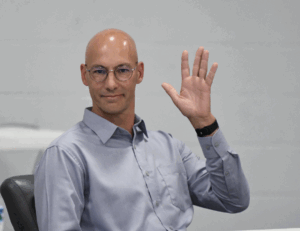
New WCPS superintendent talks 2021-22, why he applied for post
Wayne County’s new superintendent doesn’t think heading back to school this fall is going to be a cakewalk.
The challenges that the district, its administrators, staff and teachers have faced in the wake of the COVID-19 closures and restricted reopening have been enormous, Dr. David Lewis says.
So, it would be unrealistic to think that putting thousands of children back in classrooms this fall would not have its obstacles, too, he said.
But there is one aspect of the new school year that Lewis is not concerned about at all — that his staff, from Central Office personnel and administrators to principals, teachers, bus drivers, maintenance staff and cafeteria workers, are ready for the task.
In fact, it was watching them work through the pandemic that was one of the factors in his decision to apply for the position in the first place.
“I did not apply the first round,” he said.
Lewis had served as the district’s assistant superintendent for accountability and information technology and has a nearly 30-year career in education, but he has no experience as a superintendent.
He wasn’t sure he was what Wayne County Public Schools needed.
Lewis said it was important to him as a Wayne County native that the best person sit in the superintendent’s seat.
And, at first, he thought someone with actual superintendent experience or from outside the system might be a better pick.
“I wanted to make sure Wayne County ended up with the best person for the job,” he said.
So, after WCPS lost its superintendent and finance director, Lewis did not throw his name into the hat as a potential replacement for Dr. Michael Dunsmore.
Instead, he worked with interim superintendent Dr. James Merrill as the district worked its way out of a multi-million-dollar deficit and changed its entire relationship with budgeting, spending and accountability.
All of that while dealing with the pandemic and its aftermath.
When Merrill left in December, Lewis took on the role of interim superintendent.
“The longer I did the interim work, the more I realized that it could be done. Everybody really stepped up. (And I thought) maybe we did not need dramatic change. Maybe we need some stability now,” Lewis said.
The district is now out of debt and dealing with the realities of “wants vs. needs” and the challenges of limited funding that has required cutting costs, not filling certain positions and increasing class sizes.
And that has meant sacrifices on every level — from principals figuring out how to cover classes, teachers and Central Office staff stepping up to take on more responsibility and staff looking for ways to save money.
“We just divvied up the responsibilities and got it done,” he said. “We realized that if we could do more with less, we could get rid of the debt faster.”
Those measures, plus a boost from the Elementary and Secondary School Emergency Relief funds, allowed Wayne County Public Schools to find the money to retire a $2 million loan from the state as well as $3 million owed to the School Nutrition Fund.
Lewis said every step of the plan has been checked by the district’s new team of auditors to make sure it is not only advisable but that it adheres strictly to the new spending plan and budget rules.
Getting the debt paid off was important, Lewis said, but the district and school board wanted it done right.
“We wanted to make sure that we did everything by the book,” he said.
It is a standard Lewis says he and his staff, including chief financial officer Leslie Rouse, are determined to maintain.
In other words, being careful with funds, and looking at future budget needs, are still going to be a priority.
That means understanding the difference between a want and a need — and communicating that priority to the community and the Wayne County Board of Commissioners.
“(Presenting a want as a need) is how you lose trust,” he said.
Lewis said that improving communications with the community and continuing to build on the steps taken to improve the relationship between the commissioners and the school district are a priority, too.
But those projects that were the impetus for the county and school district to ask residents to approve a sales tax increase did not go away after the measure was defeated.
And while the $80 million Wayne County will receive in ESSER funds can help with facilities’ needs that address air quality and have helped keep teachers as part of the measure’s academic recovery provisions, there are still many necessary expenditures that will not be covered.
“Those funds are restricted,” Lewis said. “There is a lot we cannot use them for.”
He added that there has been some good work done in the district — a new school, improvements, additions, but that there is still a list of facilities’ needs that is growing quickly.
“The longer we wait to do something the more schools (are added to that list),” he said.
Now that the new budget and financial rules are back in place, Lewis said the district can get ready to get back to the real challenge this fall — dealing with bringing thousands of students and teachers back to class full-time after more than a year and a half of COVID-19.
“Academic recovery is going to be huge,” Lewis said. “Kids lost a lot of instructional time with their teachers, and that is going to have an effect.”
Catching up won’t happen overnight, he added.
“I am afraid this will be a multi-year process,” Lewis said. “As we go back to school, I wouldn’t expect schools to come right back and be right where we were in February 2020. Slowly but surely, we have to get back to ‘normal.’”
And when the district is “back to being good at normal,” the next step is more innovation and ways to improve and to expand educational opportunities for Wayne County students.
But Lewis wants the community to know that there was a lot of progress in Wayne County Public Schools pre-pandemic — 8 of 14 underperforming schools were back on track, with the rest making good progress toward that goal, and a long-term facilities plan was in the works.
“There was an awful lot of good news,” he said.
Getting back to that level — and moving forward — is the goal for 2021. Among those achievements are a partnership with Seymour Johnson Air Force Base to create an innovative school on base, as well as the construction of a new school in Fremont.
More partnerships and collaborations are also planned, Lewis said.
The superintendent said that the district will use lessons learned from remote learning to give students additional opportunities to expand their educational experiences.
Participation in the district’s Summer Scholars program has been encouraging, indicating that attendance in the fall also will be good, Lewis said.
“Turns out a lot of (students) want to come back to school,” he said.
Lewis said he does not anticipate any further concerns about safety protocols and other precautions necessitated by COVID-19 because of the work that has been done over the past year and a half, led by assistant superintendent Dr. Marcia Manning.
And if another pandemic concern arises, Lewis said a plan is in place.
“If you can be ready for such a thing, we are as prepared as we can be,” he said.
But as he gets ready for another school year, Wayne County’s new superintendent said its success requires more than just dedicated staff and students back in the classroom.
“Now more than ever, we are going to need your help,” he said.
Parents can work with their children at home, while volunteers can offer assistance at the schools once the new protocols have been established, Lewis said.
And if you want to see what a community “wrapping its arms around a school” can do, Lewis said, look at Carver Heights Elementary, which has gone from a school close to being taken over by the state to a thriving and improving educational facility.
“I am not sure I couldn’t make the case that we have that need a every school,” he said.
Lewis knows his new job won’t be easy, but he said he feels the support of the community and the members of the leadership team, as well as the hard work of the staff and teachers, will make this a good year for Wayne County Public Schools.
Putting the students’ needs first and getting them ready for college, for post-secondary education or a career will be Job 1.
“We have to make sure we are getting them ready for what’s coming next,” Lewis said.

A loaded discussion

Fighting for their lives

Goldsboro loses a giant

“I’m a flippin’ hurricane!”
Public Notices — Dec. 14, 2025

Belting it out

Legendary

Final Four!


